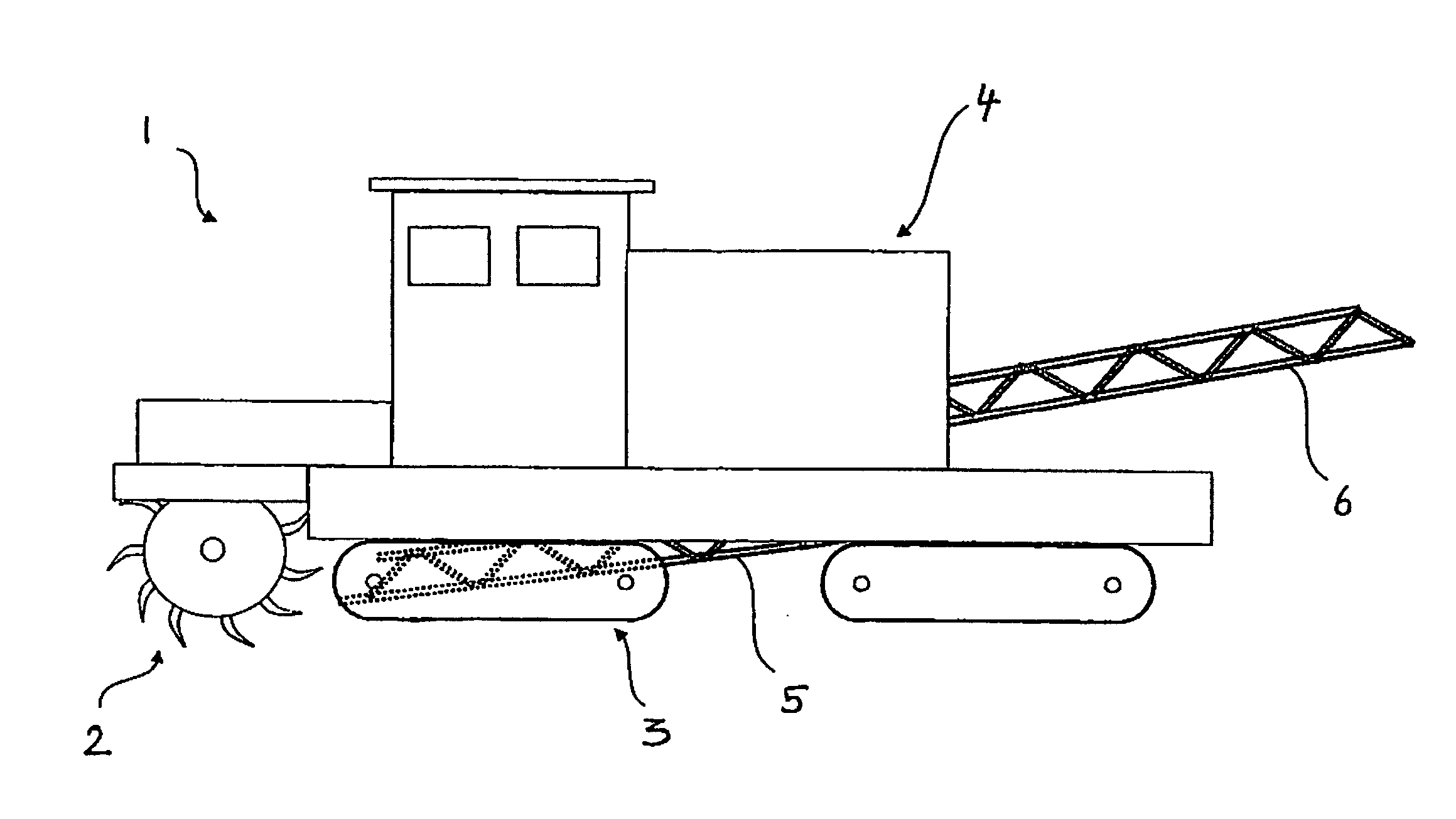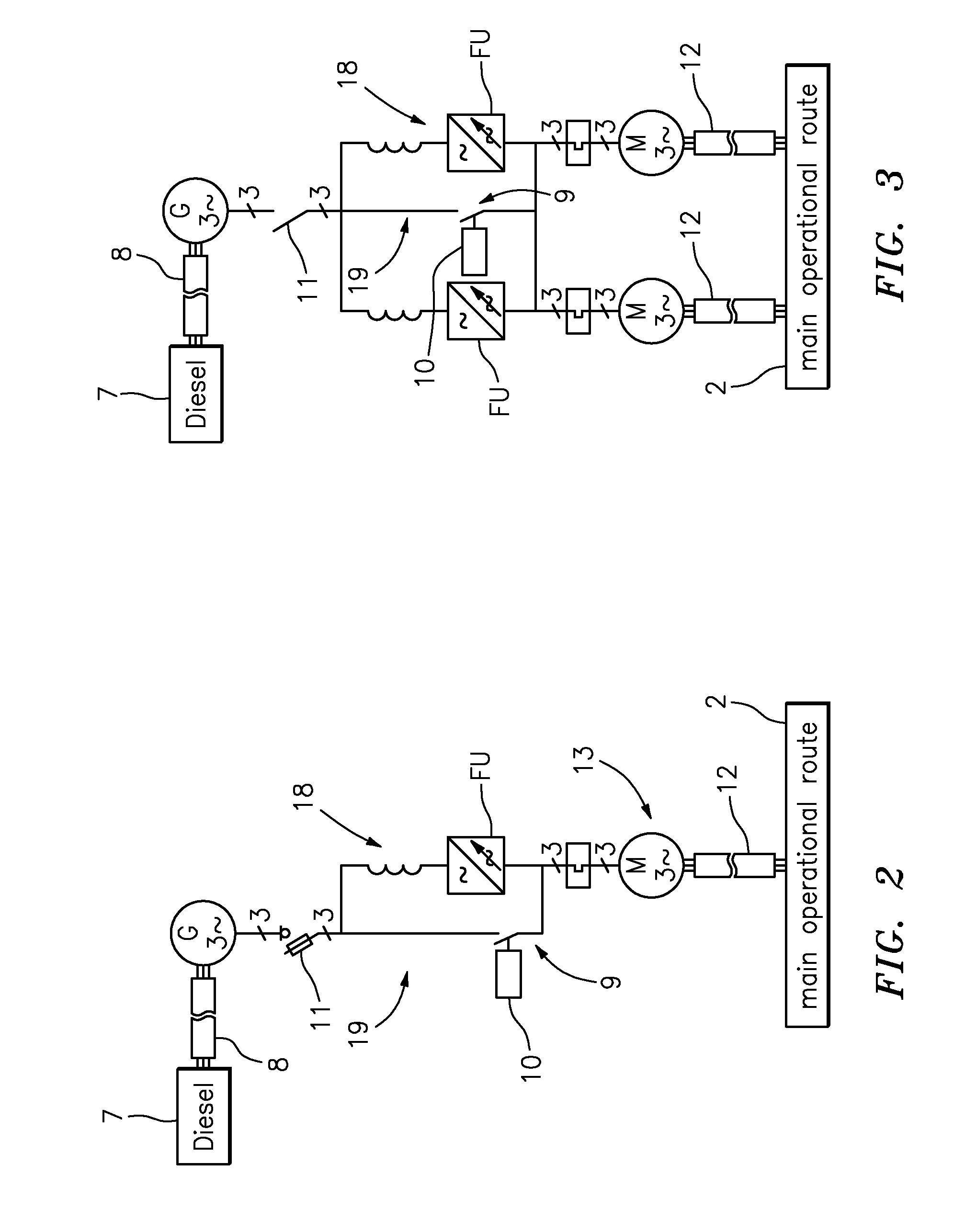The object of the present invention thus is to create an improved self-propelled working machine as well as an improved process for operating the same, avoiding the disadvantages of the state of the art, and to further develop the latter suitably. Especially, an improved efficiency and lower
operational costs shall be achieved by simple means without sacrificing a trouble-free, safe start-up.
It is thus recommended to use a frequency converter for the start-up of the drive
system to limit the start-up current, then, however, to work without the frequency converter during steady-state operation to avoid losses occurring in the frequency converter and reduced efficiency of electrical motors that occurs if they are operated with the frequency converter. After start-up of the
work unit or after having almost reached the desired steady-state operating status the frequency converter used for start-up is bypassed. According to the invention an operating circuit is provided for steady-state operation comprising a
jumper for bridging the frequency converter after start-up and / or reaching the steady-state operating status. The jumper may optionally be actuated to activate or deactivate the frequency converter of the start-up circuit respectively. Using a frequency converter during start-up phase and bridging it during steady-state operation has the following advantages:Constant or unnecessary losses in the frequency converter no longer occur during
continuous operation but are only acceptable during start-up. Especially with high performance machines this allows considerable savings in
operational costs.
Motor efficiency during steady-state can be improved because
motor efficiency is higher when directly fed by a generator or another electrical power supply having neat sinus
voltage than in case of feeding through a frequency converter.Availability will be improved and maintenance intervals may be extended as possible problems or failures of permanent operation of a frequency converter will be avoided, what especially might have strong effects in the case of extensively used machines having long term operational cycles.The insulation of the motor will not be exposed to permanent stress caused by
high voltage peaks and
high voltage variations ΔU / Δt during feeding via frequency converter.
In an embodiment of the invention the electrical power supply provides a working frequency for at least one electrical motor in a range significantly above the frequencies of known industrial power networks. Advantageously, working frequency which is used for the electrical motor for steady-state operation may be higher than 75 Hz, preferably higher than 100 Hz and may especially be in the range approximately 100 to 200 Hz. This allows realization of especially compact, and thus small and consequently low cost drive motors in limited installation spaces.
In an embodiment of the invention the frequency converter may be equipped with or may connected to a braking
resistor respectively. This allows savings of mechanical brakes which may possibly be mounted on the drive motors of the main operating unit by electrically braking the main operating unit to standstill by means of said braking
resistor. Advantageously, a braking circuit comprising a
cut-off device to separate all direct connections of the at least one electrical motor to the electrical power supply, as well as means of synchronization for
synchronizing the frequency converter or
converters to the electrical motor before
initiation of braking will be provided. Advantageously, before electric braking all direct connections of the at least one electrical motor to the electrical power supply are disconnected, for example by means of contactors, where advantageously the at least one frequency converter is synchronized to the respective electrical motor before initiating the electrical braking process.
However, in order to work with lower currents for the main drive supplying this main drive with a higher
voltage it would be advantageous. However, this higher
voltage is undesirable for the ancillary units due higher expenditures for insulation and higher costs for the frequency
converters on these ancillary units, with the respective currents being low nevertheless. Advantageously, frequency
converters are employed in the ancillary units in order to allow altering their working speed in comparison with the working speed of the main operating unit, in order to be able to adapt operation of the machine to various work and environment parameters. On the one hand, in order to be able to supply the main drive with higher voltage, and on the other hand to avoid this higher voltage for the ancillary units, in an embodiment of the invention, two voltage levels may be provided in the working machine, i.e. a higher voltage level for supplying electrical utility loads, especially electrical motors, with a high wattage, and a lower voltage level to supply the electrical utility loads, especially electrical motors, with lower wattage.
In addition to said drives for
discharge conveyors, loading conveyors and the like said ancillary units may especially also comprise at least one cooling unit which advantageously may be operated at various operating frequencies and / or various operating voltages and / or to which a frequency converter is associated to meet various cooling requirements. Advantageously, said at least one cooling unit may also be operated in the case if all ancillary units are disconnected, for example to ensure adequate cooling of the drive and supply units in high temperature environments, even in the case if the surface milling machine itself is not in operation.
Operability at various operating frequencies and / or operating voltages allows increase of cooling performance depending on the load range the machine is operated in.
 Login to View More
Login to View More  Login to View More
Login to View More 


